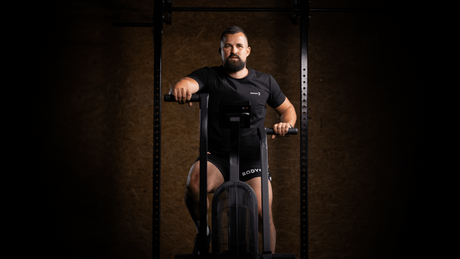We do it almost all day long, consciously or unconsciously: moving. A movement comes from the contraction (or contraction) of muscles. Three types of muscle contractions are possible: isometric, eccentric and concentric.
In the text below we will discuss these muscle contractions in relation to fitness, so that you know what happens to the muscle during an exercise and you can be more aware of the movement you make!
Isometric contraction
In an isometric contraction, the muscle provides strength, but no muscle lengthening or shortening takes place. The distance between origin and insertion, or the two places of attachment of the muscles to the bone, remains the same. The origin is static during a movement, the insert is the attachment site that moves along. The body remains in a static position during an isometric contraction and thus does not move. Logically, the same applies to the insertion of the muscle.
Isometric exercises are often used as stability training. The muscles are stimulated without movement. Examples of exercises involving isometric contraction are planking and the wall-sit.
Concentric contraction
When a muscle shortens and the distance between origin and insertion is reduced, we speak of a concentric contraction. With a dumbbell curl, this is the movement you make when the dumbbell goes upward. The muscle fights gravity and wins this battle, after which the weight moves. Another example: the concentric contraction takes place during bench press when you push the bar up. The muscle shortens again and the battle with gravity is won.
A muscle stimulus is of course also present during concentric contractions. Often the concentric contraction is performed as quickly as possible. A tip is to 'play' with the tempo at which you perform this movement. To prevent habituation, you can slightly lower the weight and slightly extend the concentric contraction to for example two to three seconds.
Eccentric contraction
The eccentric contraction is the opposite of the concentric contraction: the muscle lengthens and the distance between origin and insertion is increased. During the dumbbell curl, this is the movement that is made when the dumbbell moves downwards. During the bench press, eccentric contraction occurs when the bar descends towards the chest. Gravity wins the battle, but you determine at what rate the muscle lengthens and the weight drops.
Contrary to popular belief, an eccentric contraction, also called negative contraction or negative training, results in a large muscle stimulus. The concentric contraction is generally seen as the most important part of the exercise, while research has shown that the eccentric contraction causes more muscle stimuli. Muscle stimuli are very important in making progress, such as increasing your muscle mass.
It is important to give the eccentric contraction enough attention, at least as much as the concentric contraction. Provide controlled execution for two to three seconds. Feel the burn?



